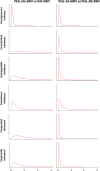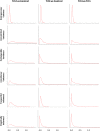Modelling heterogeneity variances in multiple treatment comparison meta-analysis--are informative priors the better solution?
- PMID: 23311298
- PMCID: PMC3554418
- DOI: 10.1186/1471-2288-13-2
Modelling heterogeneity variances in multiple treatment comparison meta-analysis--are informative priors the better solution?
Abstract
Background: Multiple treatment comparison (MTC) meta-analyses are commonly modeled in a Bayesian framework, and weakly informative priors are typically preferred to mirror familiar data driven frequentist approaches. Random-effects MTCs have commonly modeled heterogeneity under the assumption that the between-trial variance for all involved treatment comparisons are equal (i.e., the 'common variance' assumption). This approach 'borrows strength' for heterogeneity estimation across treatment comparisons, and thus, ads valuable precision when data is sparse. The homogeneous variance assumption, however, is unrealistic and can severely bias variance estimates. Consequently 95% credible intervals may not retain nominal coverage, and treatment rank probabilities may become distorted. Relaxing the homogeneous variance assumption may be equally problematic due to reduced precision. To regain good precision, moderately informative variance priors or additional mathematical assumptions may be necessary.
Methods: In this paper we describe four novel approaches to modeling heterogeneity variance - two novel model structures, and two approaches for use of moderately informative variance priors. We examine the relative performance of all approaches in two illustrative MTC data sets. We particularly compare between-study heterogeneity estimates and model fits, treatment effect estimates and 95% credible intervals, and treatment rank probabilities.
Results: In both data sets, use of moderately informative variance priors constructed from the pair wise meta-analysis data yielded the best model fit and narrower credible intervals. Imposing consistency equations on variance estimates, assuming variances to be exchangeable, or using empirically informed variance priors also yielded good model fits and narrow credible intervals. The homogeneous variance model yielded high precision at all times, but overall inadequate estimates of between-trial variances. Lastly, treatment rankings were similar among the novel approaches, but considerably different when compared with the homogenous variance approach.
Conclusions: MTC models using a homogenous variance structure appear to perform sub-optimally when between-trial variances vary between comparisons. Using informative variance priors, assuming exchangeability or imposing consistency between heterogeneity variances can all ensure sufficiently reliable and realistic heterogeneity estimation, and thus more reliable MTC inferences. All four approaches should be viable candidates for replacing or supplementing the conventional homogeneous variance MTC model, which is currently the most widely used in practice.
Figures



References
-
- Coleman C, Phung O, Cappelleri J, Baker W, Kluger J, White M, Use of network meta-analysis in systematic reviews. Under review: AHRQ; 2012.
-
- Gelman A. Prior distributions for variance parameters in hiearchical models. Bayesian Anal. 2006;1(3):515.
-
- Pullenayegum E. An informed reference prior for between-study heterogeneity in meta-analysis of binary outcomes. Stat Med. 2011;30:13. - PubMed
Publication types
MeSH terms
LinkOut - more resources
Full Text Sources
Other Literature Sources

